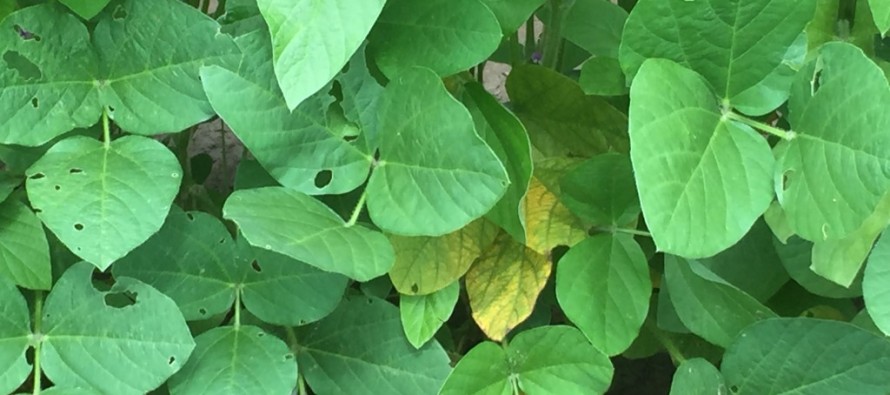Soybean “Mystery Disease” Update

By Tom Allen, Maria Tomaso-Peterson, and Trent Irby

Typical symptoms associated with the “mystery disease” in the lower plant canopy on soybean plants in the late vegetative or early reproductive stages.
Over the past several years we have observed a substantial number of soybean plants exhibiting foliar symptoms that appear similar to sudden death syndrome or other root-based issues (e.g., red crown rot, southern blight, root-knot nematode). The foliage of the affected plants develops a mild interveinal chlorosis that ranges from a minimal amount of chlorosis to a set of trifoliate leaves becoming completely yellow (see associated images). The associated foliar symptoms can oftentimes be observed in vegetative growth stages with the majority of the symptom expression beginning in the mid-reproductive growth stages (>R5). Keep in mind that the interveinal chlorosis associated with sudden death syndrome (SDS) will generally not be observed until late reproductive growth stages (> R5.5). Whole plants that are carefully removed from the soil can oftentimes be missing a taproot, have a blackened mass growing around the root, blackened lateral roots, and if a whole root is removed from the soil the taproot will easily break in two as the plant tissue feels brittle. In addition, plants at advanced reproductive growth stages will have a general staining of the vascular tissues. In general, either single plants in a field exhibit symptoms or small clumps of plants can be observed to exhibit symptoms generally along the same row within a field. During 2007 and 2008 the disease was generally thought to only occur in field situations where light soil classes were encountered. However, since that time the disease has been observed in almost every soil class encountered in MS, regardless of soybean variety as well as irrigation practice. Moreover, the disease has been observed from south MS to north MS typically in small scattered areas of fields. However, during 2014, and likely due to the cooler and wetter than normal environmental conditions encountered, we observed increased levels of this particular disease.

Light interveinal chlorosis associated with the “mystery disease”. Not all plants will develop this symptom and the general symptom should not be confused with SDS.
Numerous people have made statements about the disease that at this point we are referring to as the “mystery disease”. In some cases since 2007 the disease has also been referred to as “black root rot”. However, the fungus that causes black root rot, Thielaviopsis basicola, has not been recovered from infected plant or root systems in MS.
For the 2015 season there are likely no management practices that can be implemented to reduce the potential yield loss that can be associated with the disease. However, research is currently underway at MSU, as well as at the University of Arkansas and LSU AgCenter, to determine the specific causal organism so that field-level trials can begin to determine the best method of combatting the disease. The work in MS was supported by the Mississippi Soybean Promotion Board.
Several steps are necessary in properly diagnosing/characterizing a plant disease:
- Collect plant tissue samples with the disease in question.
- Isolate the organism from the plant in the laboratory.
- Use general microbiological growth medium.
- If the organism is an obligate parasite and requires living plant material to grow then a growth medium will not work; however, if the organism will sporulate then tools can be used to isolate and collect the fungal fruiting structures for additional observation.
- Correctly identify the specific organism involved in causing the disease.

Leaves on infected plants, observed in the lower plant canopy at vegetative growth stages, can also develop a “leaopard-print” type appearance.
Also, as a bit of clarification, what is in a name can be confusing. Since the “mystery disease” was first observed (ca. 2006/2007, if not earlier) the disease has likely been referred to using several different names. Over the years:
-“mystery disease”
-black root rot
-generalized root rot
At this point, even if we have isolated the causal organism the name will remain “mystery disease” until the greenhouse trials have been completed and we definitively determine the specific causal organism. With this in mind, before we can determine how to manage the disease the greenhouse trials as well as additional plant tissue sampling will be conducted throughout the 2015 season to determine the organism(s) involved and how we can best manage those.





Let me tell You a sad story ! There are no comments yet, but You can be first one to comment this article.
Write a comment